Why we chose Montessori – the philosophy, and my favorite reading material
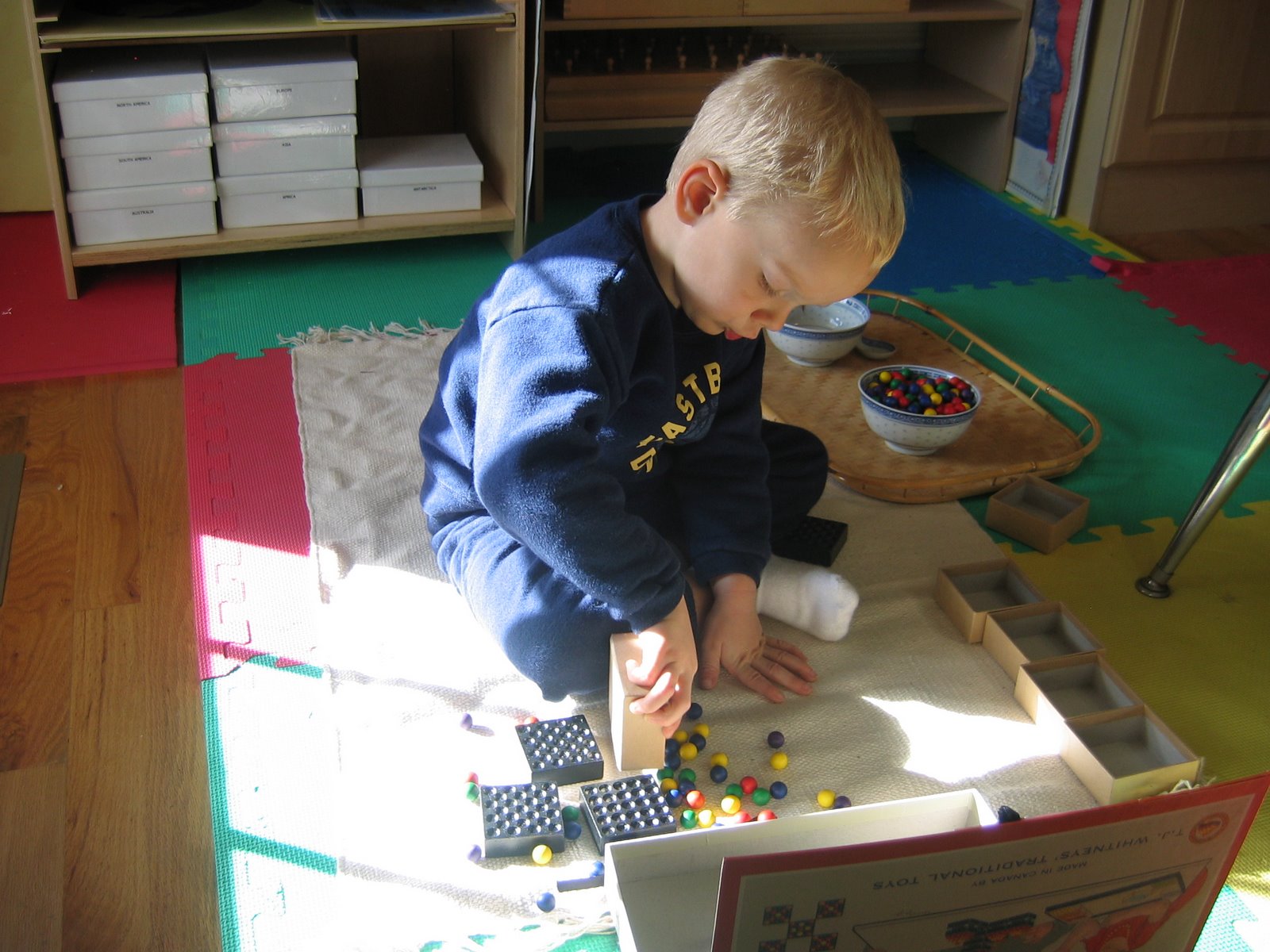 As promised, I am starting my Montessori series. I have been busy with life lately. I really wanted to start this earlier. Oh well, here are my thoughts on why we made the journey into Montessori, and why I stay with it – even at 7 months pregnant!
As promised, I am starting my Montessori series. I have been busy with life lately. I really wanted to start this earlier. Oh well, here are my thoughts on why we made the journey into Montessori, and why I stay with it – even at 7 months pregnant!
I have always been drawn to Montessori, even from the beginning of our homeschooling experience – about 9 years ago! We dabbled. The concept fascinated me, but I never invested the 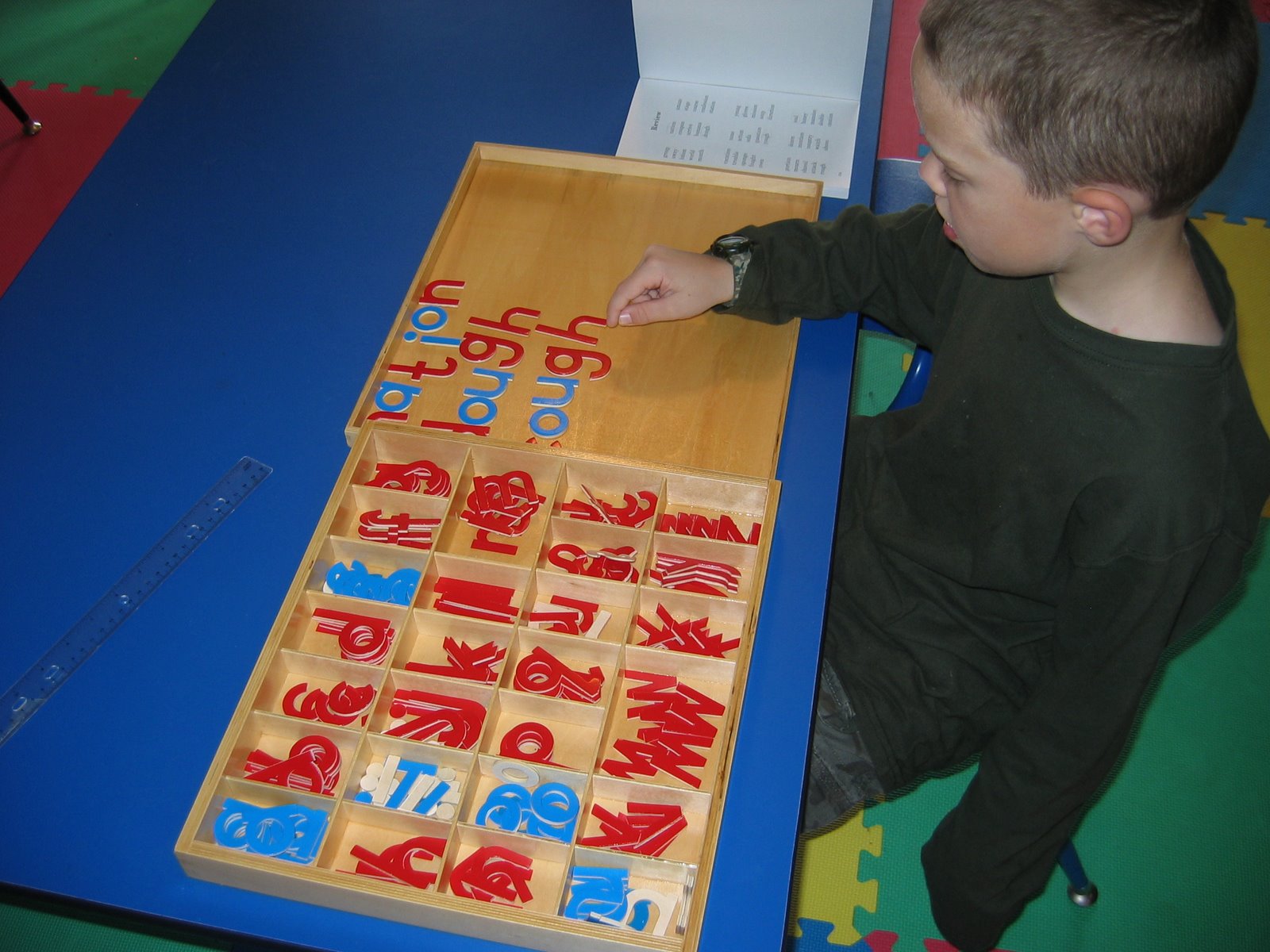 time to *really* learn it until a couple of years ago when prompted by some specific needs of our then 5/6 year old son.
time to *really* learn it until a couple of years ago when prompted by some specific needs of our then 5/6 year old son.
Homeschooling is such an ever-evolving process. It changes constantly, adapting to the needs of the children, the ever changing sanity of mom, the crisis of the moment, the expansion of families, etc. In a home, there is a sort of tapestry being woven by God in the day to day ordinary stuff. It is naive to think that once you get started and settled, you’ve got it figured out! Because right about that time, God begins to weave in a different direction, in a different color, and usually an altogether different pattern. Here’s when you try to force a square peg into a round hole (usually because you’ve already purchased all the curriculum for the round hole, and by golly, you’re going to get that square peg of yours into it!) Our Sparkly is a square peg! 🙂
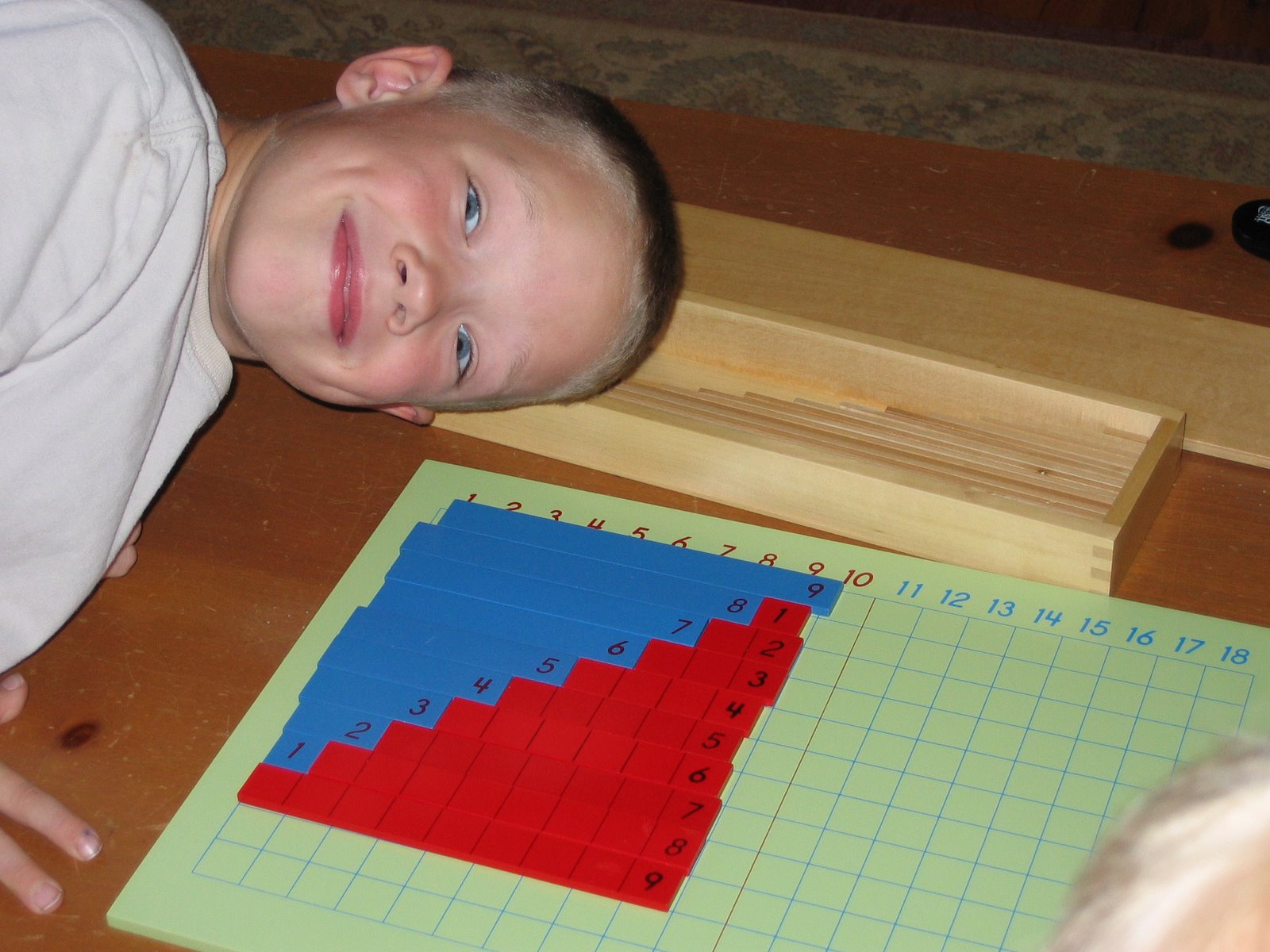 Now, after having read what I’ve read about Montessori, and learned her philosophy and the beautiful principles, I believe them to be universal in their ability to *fit* any particular child. But, for our family, in our tapestry, Sparkly was the catalyst that jump-started our journey. It became clear that Sparkly wasn’t the kind of kid that was going to learn – I mean really learn – in any of the ways I was trying to teach. For a few subjects, he was a sponge, for others (most other subjects) he was a brick wall. Ever tried to teach a brick wall? Frustrating. He wasn’t making a connection. So I began to observe him, I mean really watch how he learned. It didn’t take long to see that he needed to interact with his learning environment. He benefited from figuring things out on his own. Montessori!
Now, after having read what I’ve read about Montessori, and learned her philosophy and the beautiful principles, I believe them to be universal in their ability to *fit* any particular child. But, for our family, in our tapestry, Sparkly was the catalyst that jump-started our journey. It became clear that Sparkly wasn’t the kind of kid that was going to learn – I mean really learn – in any of the ways I was trying to teach. For a few subjects, he was a sponge, for others (most other subjects) he was a brick wall. Ever tried to teach a brick wall? Frustrating. He wasn’t making a connection. So I began to observe him, I mean really watch how he learned. It didn’t take long to see that he needed to interact with his learning environment. He benefited from figuring things out on his own. Montessori!
I started reading all I could, and what I began learning from Maria Montessori really spoke to my heart, my desires for my children, and began to open up for me a whole new way of thinking about learning in our home. It spoke to the “wholeness” of our family, not just Sparkly’s individual needs, which made it a very worthwhile investment of my time and effort. Our lives have been unspeakably enriched just by implementing Maria Montessori’s basic philosophy into the “daily ordinariness.”
So, after all that, just who is Maria Montessori? And what is the Montessori Method? I’m not going to re-invent the wheel here, there are so many sites that can sum up Maria better than I can, plus I’ve got to get the spaghetti on in a few minutes. First, I’ll say that Maria was a devout Catholic! And her philosophy is permeated with the beauty that is infused by Holy Mother Church. Not in a forced sort of artificial way, but in the way that truth and beauty are always recognized – in a universal way, in a way that all hearts can recognize. She was an Italian, born in 1870. She died in 1952 after making a tremedous impact on education. The Michael Olaf site has a wonderful bio of her, along with many pictures!
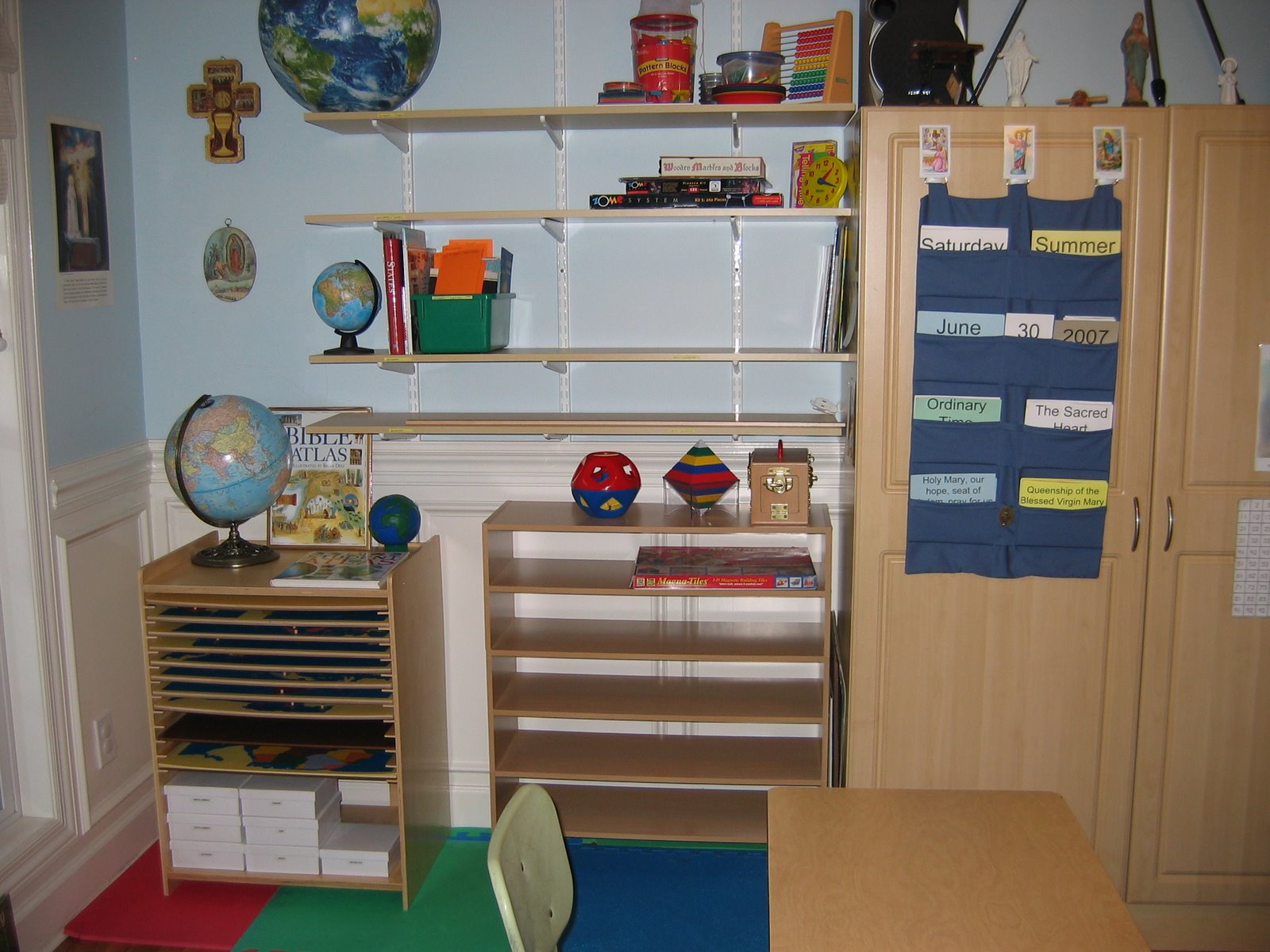 The Montessori philosophy has a few basics at its heart. It is about the child’s environment. Maria believed and then observed that a child’s environment was key to their ability to learn. The environment needed to be attractive, filled with beauty and order. She observed that a child learns not by “being taught,” but rather by observing and making valuable connections on their own taking advantage of periods when a child is particularly open or sensitive to a new concept. The environment and the materials within that environment are presented and available in a way
The Montessori philosophy has a few basics at its heart. It is about the child’s environment. Maria believed and then observed that a child’s environment was key to their ability to learn. The environment needed to be attractive, filled with beauty and order. She observed that a child learns not by “being taught,” but rather by observing and making valuable connections on their own taking advantage of periods when a child is particularly open or sensitive to a new concept. The environment and the materials within that environment are presented and available in a way 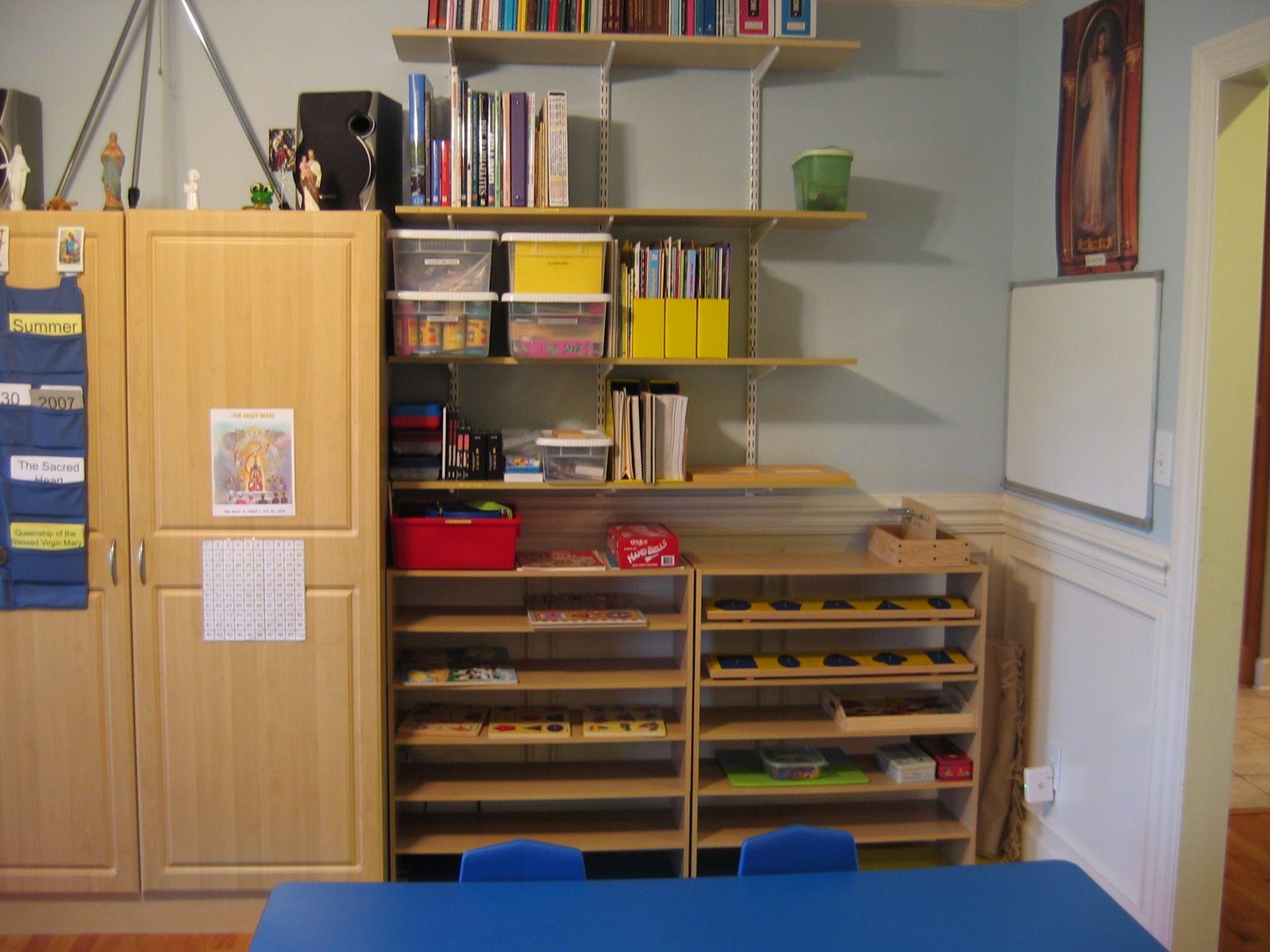 that is both attractive and facilitates those connections. It is about a level of freedom within limits. Montessori is about moving from concrete to abstract. These ideals fit beautifully into what I was already trying to do, and with my very Charlotte Mason teaching style. I’ve attempted to sum up in a paragraph what many books spend pages and pages summarizing and articulating. I hope I haven’t done it a dis-service.
that is both attractive and facilitates those connections. It is about a level of freedom within limits. Montessori is about moving from concrete to abstract. These ideals fit beautifully into what I was already trying to do, and with my very Charlotte Mason teaching style. I’ve attempted to sum up in a paragraph what many books spend pages and pages summarizing and articulating. I hope I haven’t done it a dis-service.
As a final thought, I’ll leave you with a few of my favorite reads. These books helped me flesh out the ideals and practical applications of Montessori. This is by no means a comprehensive list, a quick search on Amazon would yield a number of other options. These books helped me put into practice a method of education which some would insist is best left to an institution with trained professionals. I do not discount the great value a trained Montessori teacher brings to the picture, but I vehemently oppose and disagree with the idea that I cannot learn. Motivated by my desire to provide a beautiful, living education for my own children, and certain that God provides the necessary graces to accomplish the education of His children, I am confident I can appreciate, implement, and generally translate the Montessori philosophy into my own home.
The Montessori Method by Maria Montessori – A good overview of her philosophy in her own words. I found it a little technical at times.
Montessori: A Modern Approach by Paula Polk Lillard – this was a good general info book for me.
Montessori Today by Paula Polk Lillard – I really enjoy this author and her realistic approach.
Montessori in the Classroom by Paula Polk Lillard – This was one of the most helpful books for me in terms of seeing how all of the philosophies translated into real life. The struggles and challenges she candidly writes about were extremely helpful.
Teach Me To Do It Myself by Maja Pitamic – it was ok, but I preferred the Hainstock books (linked below) more for this type of information.
Montessori Play and Learn by Lesley Britton – this book has some good ideas for implementation, but again, I preferred the Hainstock books.
Teaching Montessori in the Home: The Preschool Years and Teaching Montessori in the Home: The School Years by Elizabeth Hainstock – these are two of my absolute favorites. Gives detailed descriptions on key presentations, how to offer the presentations, and how to make many of the materials – a plus on a homeschool budget. These are real gems!!!
The Michael Olaf catalogs – They Joyful Child and Child of the World – are basically half catalog and half information. They really offer quite a bit of extraordinary information, and the catalogs are nice too!!!! You can download the PDF as another option.
The Nienhuis catalogs were free for the asking. They are sort of the cadillac of Montessori. They set the standards, and their prices reflect it!!!! Beautiful materials, awesome quality, never affordable to this family! But….the catalogs do provide some info, and sometimes you can duplicate or make your own material with a really good picture.
Some of my favorite online resources for information:
Montessori For Everyone blog – Lori is a trained Montessori teacher, and has brought Montessori home to her children in the homeschool setting. This is without a doubt the most valuable resource I’ve come across. Her blog is full of pertinent information about homeschooling Montessori. There is always something there for me. Anyone interested in learning about implementing Montessori in their home ought to be a regular visitor here.
JMJ Publishing’s Montessori pages – these offer some great resources, information and free downloads.
Montessori Teacher’s Collective (Album Pages) – too much great info here! Very helpful for me as it is one of the few sites online that offers presentations for the child over 6.
Montessori World Educational Institute – another favorite source of presentations.
Well, I think that’s it for most of my favorite Montessori resources. There are certainly others.
My next post will/should be about how we implement Montessori in our home. Homeschooling Montessori is very different from a “school setting” of Montessori, and as I mentioned before, we’re NOT Montessori purists. Hope you enjoy, and hope this was helpful for those of you asking for more details as to our reasons and motives for choosing Montessori!





That is so interesting…it is so much fun to read your post. Have a Blessed Christmas!!
WOW! Great post, and what a complete collection of links!
Jen, I am blown away by your words of praise for my blog. I can’t tell you how much it means to me! I have worked so hard on it, and to see other people benefiting from that hard work is a dream come true. I’m so glad you’ve chosen Montessori! I’m always inspired by your blog as well =)
Hi, Jen i was wondering how can i see your Wildflowers and Marbles journal?Dessi Jackson
looking forward to your implementation comments. Thanks for sharing all these great links.
Jen,Email me at jdjackson17 (at) hotmail (dot) com.Dessi
Super well done Hennious! It (your post) seems a perfect intro to Montessori, ‘course I may be a <> little<> biased
Just a smidge biased I suppose 🙂 UC. I’m glad you stopped by!Thank you all for your kind comments, this was fun to put together. I’m looking forward to writing more on it.Lori, I’m so glad you enjoyed the post. You and your blog are a great inspiration to MANY of us! And you continue to be a source of rich information for me anytime I feel *stuck.*
Have you also read about Catechesis of the Good Shepherd, a religious curriculum developed by Sofia Cavaletti, a student of Maria’s? I would recommend Sofia’s book “The Religious Potential of the Child.” If you think you are blown away by the beauty the Montessori method brings out in your children, just wait til you set up an Atrium in your home!Barring finding the book, you can start with this link: http://www.cgsusa.org/
Dear CGS catechist – Yes! We do love the Catechesis of the Good Shepherd as well. I chose not to blog about it in this particular post because I wanted to devote a whole post on the why’s and wherefore’s of CGS. We have set up a dedicated home atrium in our home. If you check out the labels in the Right column of my blog, you’ll see Catechesis of the Good Shepherd listed. These contain some of our very first experiences with this extraordinary program! I completely concur with your suggestion of reading material – I’ve read them and they were so uplifting and educational for me. I’ll post much more in detail on this later! 🙂 Thanks for popping in here – hope you’ll check back on us later!Jennifer
Jen,I feel like you read my mind. Only said everything better than I could have. Love the info! Thanks so much!
I’m so glad I “found” your site at the beginning of this series…I am strongly considering a shift to this method, especially with my almost 3yo son!